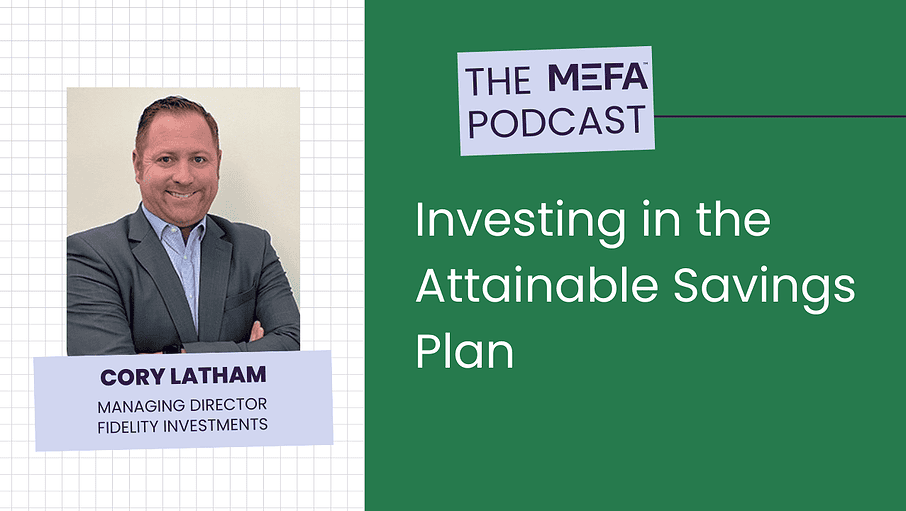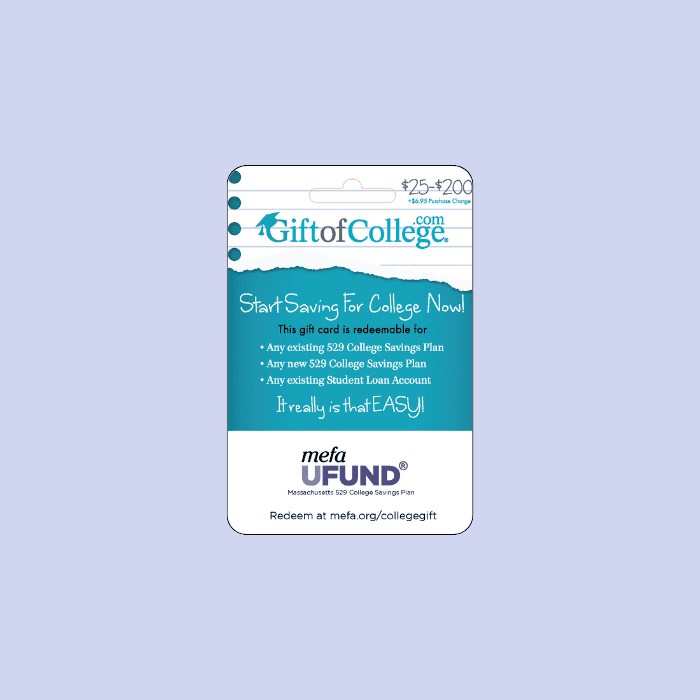

Resources Mentioned in this Episode
Jonathan Hughes: [00:00:00] What can you tell me about the investments? Choices? With Attainable® and how might that be the same or different than you fund?
Cory Latham: I’ll start by talking about what we currently have as investment options within the Attainable® savings plan right now. So we have nine investment options in there across a risk spectrum, and that ranges from a money market.
to conservative, all the way up to aggressive growth. So what I’ll do is I’ll explain what those choices are and I’m going to say a percentage at the end of these and what that percentage indicates is that’s the amount of stocks or equities in that portfolio and that’s what makes it aggressive. So as it becomes a more aggressive portfolio, you’ll see a higher percentage of equities in there.[00:01:00]
Jonathan Hughes: Hello everyone and welcome to the MEFA podcast. My name is Jonathan Hughes and you just heard our guest on the show Cory Latham from Fidelity Investments And if you heard his last appearance on the show, you’ll know that it was just a short time ago You see Fidelity Investments works with MEFA to offer the UFUND 529 college investing plan as well as the Attainable® savings program And when Cory was here last, we talked about investing for college.
And in the course of that conversation, Cory mentioned that it might be worth having a separate Investment 101 type conversation about ABLE accounts. And wouldn’t you know it, August coming up right around the corner is ABLE to Save Month, where we work to highlight ABLE plans, And promote their awareness.
In fact, to that end, we just had MEFA’s Director of Able Outreach, Adam Hartwell, on the show a few weeks ago. But we thought that this discussion still belongs right [00:02:00] there in August as well. Thanks to Cory, I’m going to be back to wrap up the show in about 20 minutes. In the meantime, let’s get reacquainted with our guest on today’s show.
Cory Latham: So my name is Cory Latham. I am one of the managing directors at Fidelity Investments, and I am the state relationship manager for MEFA, which includes the U Fund plan, but it also includes the Attainable® savings plan. So I work directly hand in hand With MEFA in the state, making sure that we can provide best in class products and services and really meet the needs of both you find in for today, specifically Attainable® savers.
Jonathan Hughes: Yeah. And last time you were on, we talked about you fund and we talked about investing in the U fund. And during that conversation, we realized. This is probably a topic to talk about with Attainable® specifically as well. August being Attainable® or able month. We thought, why don’t we come back and talk about able and specifically Attainable® which is the [00:03:00] Massachusetts able program.
But why don’t I let you talk about that before we get into the, Investing questions. Can you just go over at a high level what the Attainable Program is and what ABLE accounts are in general?
Cory Latham: Yeah, happy to do that. ABLE accounts, they are tax advantage accounts that allow for individuals with qualifying disabilities to save for both short and long-term needs.
So accounts can be either opened by an individual Or on behalf of an individual and what’s really key about those is that any earnings in the account grow federally tax deferred. And if used for a qualified disability expense, those distributions are tax free. And another important key part with ABLE accounts is any money in the account does not impact the beneficiary’s SSI or Medicaid.
If the balance in that account remains below 100,000. So those are like the two big benefits when it comes to ABLE accounts.
Jonathan Hughes: Can you spend just a minute and [00:04:00] talk about why the 100, 000 limit is such a big
Cory Latham: Yeah, so for a lot of folks, it’s really, there’s that 2, 000 limit of the savings amount that they’re able to have before benefits are going to get impacted in one way or another.
So what it allows here is that you can get up to 100,000. And with ABLE accounts, I think it’s also important to understand that there are yearly limits of what you can put in. So currently right now for this year, it’s 18,000. If you do work, then you do have the ability to contribute more, but based upon the amount that you’re able to contribute, you can’t just put in a hundred thousand dollars or whatever amount to get there.
So that will get there through periodic investing. However you’re going about it. Along with potential growth within the plan. But what it really shows is that’s a pretty high number to get at. So you are able to save a significant amount of money [00:05:00] before you have to worry about it, impacting any of the benefits that you’re going to get.
So that high number is really up there. And if you get there. I think the understanding is that you would then be able to potentially not need some of the benefits that are being offered, but all the way up to that climb, that is a significant amount that you can save that will help you meet any of those, financial needs that you would have.
Jonathan Hughes: Comparing this to what we talked about last time, which is the 529 plan specifically for college, those are used for educational expenses, what are the qualifying expenses for ABLE programs?
Cory Latham: Yeah, it’s very broad. And what I’m actually going to do right now is I’m going to read to you the exact definition.
Because I think it’s important to understand that that there’s a lot that you can learn about it from this definition, but a lot that’s can be taken from it.
Jonathan Hughes: Yep.
Cory Latham: Qualified disability expenses are expenses for the benefit of the account owner, who’s the beneficiary, in maintaining or [00:06:00] improving his or her health, independence, or quality of life.
So these expenses include, but not limited to, so that’s a key term, not limited to, education, housing, transportation, employment, training and support, assistive technologies and related services, as well as, personal support services or health and basic living expenses. So I mentioned that’s a very broad scale of what it can be used for.
And obviously every disability has its own unique set of circumstances. So there’s different needs that some may need that others won’t. So the way that’s defined is, It leaves it broad so that you are able to meet a significant amount of those Additional expenses that you would have just as the result of having to you know Live life with the disability that the beneficiary has
Jonathan Hughes: Okay, and so i’ve mentioned able and Attainable® a few times. Can you explain the difference between those two things?
Cory Latham: I can. So an ABLE account [00:07:00] is the account type. So like 529 IRA, that is the definition of what the account is. What the Attainable® savings plan is that’s the account that’s offered through BIFA. So they’re the ones that offer. They’re state sponsored, similar to the way that a 529 plan is.
So if you’re familiar with that, so every state has the ability to offer one. So MEFA offers the Attainable® savings plan and we manage it here at Fidelity Investments, similar to what we do at the U Fund.
Jonathan Hughes: Yeah. And so like with the U Fund, you also manage. The accounts and what people call up about their accounts are talking to fidelity, but also the investments, right?
And so there might be, as we mentioned, you were on before to talk about. different investment options and terms and just general sort of philosophy of investments when I was relating to the U Fund. What can you tell me about the investment choices with Attainable® [00:08:00] and how Might that be the same or different than U.Fund?
Cory Latham: Yeah. It’s an important topic because there are things that are the same and there are things that are different. I’ll make sure that we take some time to discuss each of those. So I’ll start by talking about what we currently have. As investment options within the Attainable® savings plan right now.
So we have nine investment options in there across a risk spectrum, and that ranges from a money market to conservative all the way up to aggressive growth. So what I’ll do is I’ll explain what those choices are, and I’m going to say a percentage at the end of these and what that percentage indicates is that’s the amount of stocks or equities in that portfolio. And that’s what makes it aggressive. So as it becomes a more aggressive portfolio, you’ll see a higher percentage of equities in there.
Jonathan Hughes: So equities is more aggressive.
Cory Latham: Yes. Yep. So when you have a, when you [00:09:00] have a portfolio that has a higher equity percentage, as opposed to things such as More conservative investments that will be more on the aggressive end of the risk spectrum.
Jonathan Hughes: This is great. So you won’t have to pretend that you’re talking to somebody who doesn’t know anything about investments. I really don’t know anything. No, that’s good. That’s good because I tend to think I’m representative of a lot of people. So yeah, no, this is great.
Cory Latham: Yeah, of course. I’ll set it. So we have our money market portfolio. We have our conservative income and that’s 20 percent equity. As I mentioned, that’s more on the conservative side of the risk spectrum. We have income 30%. moderate income, 40 percent balanced, 50 percent moderate growth, 60 percent growth, 70 percent and aggressive growth, 85%.
And in addition to that, we also offer a multi asset index portfolio, which is also at that 85 percent equity portfolio. So it does really help [00:10:00] based upon the definition of it. If you don’t know What does conservative or income or moderate growth mean? You can always understand that percentage means that’s how much is invested in the more aggressive portion of the portfolio, which is the equity portion of it.
Jonathan Hughes: And last time, and I know we have to be careful how we talk about investments and what is appropriate and certain for certain circumstances or whatnot. But last time you were here, we talked about the different categories. So we had custom versus age based, right? And the age base I’m thinking about in particular because I know that most of the assets held And the 529 is in age based and not in the custom portfolio. So age based means you tell me what age based is.
Cory Latham: Yeah, you’re doing a great job though. I don’t know a lot about investments, but your definitions are pretty straight on. I think you got to give yourself a little bit more credit. But I’m happy to talk about it. So when we mentioned that you fund and Attainable® have different options when it comes to [00:11:00] investing, when you’re building out the investment lineup for each type of account, you want to make sure that you have the right investments for the needs of that specific account.
When it comes to you fund and Attainable®, they both have Target risk in there, right? So there, that exists both in the Attainable® plan as well as in the youth fund plan. But when it comes to a five 29 plan, typically there’s a set time when you’re going to need those funds, right? So if you’re saying it’s from birth to 18 years, or you have an anticipation of when they’re going to use those funds for a higher education expense.
Now, sometimes that doesn’t happen, which is why you have other options, but typically you’ll see people say, I need it in 18 years when it comes to able. That doesn’t really exist. There’s not a set need for the funds where it says, Hey, everyone’s going to need it in 5, 10, 15 years or two days or two months.
So what you want to look at is what’s the right lineup for that type of [00:12:00] investor. So that’s where we came along with the risk spectrum that we mentioned. It exists in UFund, it exists in Attainable, and the reason is, what you want to make sure you have is the right lineup for the needs of those individuals within it.
Jonathan Hughes: Some of those goals, as you mentioned, might be short term goals, some of them might be longer term goals, is that right?
Cory Latham: Yeah, of course. So that’s one of the beauties of what the ABLE account is that it really can be whatever you need it to be. So if you want it for a short term need or a long term need, or both, or in between, really, whatever the needs you have. The ABLE account fills that based upon the different strategies that you can have.
Jonathan Hughes: Do we know percentage wise where most of the people or where most assets tend to exist on the risk spectrum?
Cory Latham: Yeah, I think it’s pretty well split. Okay. So I think that I would say is that this is that I think the question comes up a lot, right?
Do you, people use it [00:13:00] short term or long-term more? What is the, how are people using it? And what we see is that. I wouldn’t be able to say it’s really one or the other, everybody is just setting it and forgetting it or everybody is just bringing the money in so that they can utilize it right away.
So what we like to talk about is, there’s principles and attributes that can help you determine what’s appropriate for you. So if you are investing for a short term goal, And preservation of capital is important. You’re going to need that money, right? So that you want to prefer something more on a conservative side.
If you have a longer term horizon or a higher risk tolerance, you might want to consider a more aggressive portfolio. And then really what it comes down to are your individual circumstances. What’s your risk tolerance? And we mentioned earlier, right? You can be conservative, risky, Anywhere in between but what you want to be thinking about ultimately [00:14:00] is what is my goal for this account and you can have Not just one.
That’s the beauty of the account. You can have some of it be for short term some of it for long term it really is flexible in the way that you can determine it you don’t have to just be in one of the investments That we have you could be in the most conservative you could have some a portion of your account in the most conservative a portion of your account the most aggressive it’s similar to how we discussed it with 529 You do have flexibility in choosing what you want to be invested in.
Jonathan Hughes: It’s not just one choice since this is an account where People are going to have to be you know Withdrawing for regularly occurring expenses. How do they actually use funds that they’ve invested?
Cory Latham: Yeah, so there’s a couple of different ways you can do that. The first is you can just do a distribution from the account directly. So if you wanted to have funds sent to yourself, you’re able to just really log into fidelity. com, manage your account [00:15:00] that way. We have Attainable® savings specialists who you would be able to contact. through our phone site. You’d be able to have a conversation with them. They could help you with it. But what we also have and what we share as an option is we also have cash management accounts and what those cash management accounts are.
Those are accounts that you have that are those traditional accounts that would have check writing or a debit card associated with it. What you’re able to do Is you can withdraw your funds into that account and then you can use either that debit card or the check writing feature, whatever you’d want to have set up and use that to not only pay the expenses, but to be able to track them because it can be important to make sure that you’re tracking the expenses that you have, depending upon what you’re using them for.
But that is something that’s available for people to be able to do. And it can help you from an ease of having that debit card or the check writing but also the ability to track where that money is being used and how it’s being used. Or, if you’re a long-term investor, you just let it stay in there and have take advantage of that potential growth.
Jonathan Hughes: And [00:16:00] why is that tracking important?
Cory Latham: Yeah, so the, when we come down to what’s a qualified expense it’s very broad. And I think that anytime anyone’s taking Funds out and using them for something. You would always encourage them to make sure that they are just keeping records of it because you never know when a question might come up or something like that, this would allow you to know where the debit card was used, right?
Where the check was made out to who was made out to you can use all of those benefits of as well, but I think it’s just one of those best practices. That we’re probably all taught as we’re going up. And for me, it was learning how to keep a checkbook. I’m not sure that still is a skill that everyone’s learning these days, but always making sure to keep track of, your receipts and your spending. So that in case anything ever came up, you would have those records available to yourself to be able to share.
Jonathan Hughes: The impetus to have you on last time to talk about investing is that [00:17:00] unfamiliarity with investing Hesitancy with investing people who don’t really know too much about investing that can lead them to delay or to not open an account in general. Do you see similar concerns in able as we do in the 529 with that?
Cory Latham: We do we definitely see similar concerns when it comes to able from that space But I’ll also say I think the bigger picture concern we see when it comes to ABLE is people just don’t know about it. I think everyone seems to know a lot more about a 529.
I think that’s just a little bit more prevalent. When it comes to ABLE, it’s an amazing amount of people you talk to who just didn’t know that it existed. So what we want to really do is focus on getting the message out there of how it can benefit those who can utilize it. When we speak with people, and explain to them what the benefits are.
That really helps, but with investments, you see the concern as well. And a lot of what it can come down to is it’s the first investment account someone’s had, [00:18:00] and you have to choose an investment. It’s set up similar to a way of five 29 plan is you do have to have it. What we tell people all the time, and I mentioned it on the last podcast.
If you ever have your on again. You’ll hear me say it again is that you don’t want that to be a barrier to entry to opening up the account because there is a ton of resources out there that can help you with it. We have resources on fidelity. com. We have there’s resources all out in the web, anywhere you want to look.
We do have those Attainable® specialists who would be able to help you with it. And what they’re going to be able to do is they’re going to be able to talk with you about, hey, this is what this investment means. Or basically the conversation that we just had earlier, they can help you understand it. So know that if that is a hesitancy and opening up the account or you’re concerned about it, there’s so much out there for you to take advantage of that will help make you comfortable when you’re making that investment decision.
Jonathan Hughes: Is there anything else [00:19:00] that people should know? About the Attainable® program. And if you were imagining someone listening to this, who may be well served by opening an able or Attainable® account but they’re hesitant either because of the investing piece or another reason what is something that they should consider?
Cory Latham: Yeah, I’m very passionate about the account myself. I think it’s just an incredible account and it offers so much value to people in helping to meet needs that could be challenging for them in their lives. The ability for the SSI and the Medicaid not impacting the benefits there. That’s huge. The tax deferred growth and tax-free withdrawals for those qualified expenses.
When you need them. I think those are just really incredible, powerful tools that this account has. So when it comes to what people, what I want to share with people is there anything else they need to [00:20:00] know for me? Jonathan, that’s always, I just want to tell you the account exists. I’m fortunate enough in my job where I’m able to get out in the community and have conversations with folks.
I was just recently in an event that was in support of the special ethics and had. A lot of conversations with people and some of them were great. They really understood the account. They were asking detailed questions and really helping educate them on it. And then a lot of people were coming up and just saying, what is this?
And then I would say it’s enabling I don’t have any idea what that is. That’s a great opportunity for me to be able to have that discussion. Discussion with individuals and talk with them about it, but you just hope that through those conversations that they’re educating more people about it because it’s just an incredibly beneficial thing that can help those people out who need it the most.
And it really does just have great advantages that can help out beneficiaries. For me, it’s all about learning about it. Learn about Attainable®, know what it is. [00:21:00] If you think, somebody who could benefit from it, share it with them. And really it’s just about getting the word out there, getting the message out there.
Jonathan Hughes: We certainly appreciate doing everything that you’re doing and fidelity as well. And we’ll put the. information for Fidelity, for the ABLE department, for the Attainable® folks in the show notes. So if people have questions, they can reach Fidelity. Always grateful to have you as a resource and grateful to have you on the show with us again, Cory. Thank you so much.
Cory Latham: Yeah, I appreciate you having me on. Thank you.
Jonathan Hughes: Alright folks, that was our episode. I want to thank Cory Latham, of course, from Fidelity for being here and sharing his passion and his expertise with all of us on the show. And folks, if you liked what you heard on the show and you want to [00:22:00] hear more from us on planning, saving, and paying for college and career planning, then you can follow the show and you can find us wherever you find us.
Oh, and please remember to rate and review us. It helps us to keep doing what we’re doing and getting this show out to folks like you. I want to thank Shaun Connolly, our producer. I want to thank AJ Yee, Lisa Rooney, Lauren Danz, and Meredith Clement for their assistance in getting the show posted. I will be back next Tuesday with a new episode.
Once again, my name is Jonathan Hughes and this has been the MEFA podcast. Thank you.















